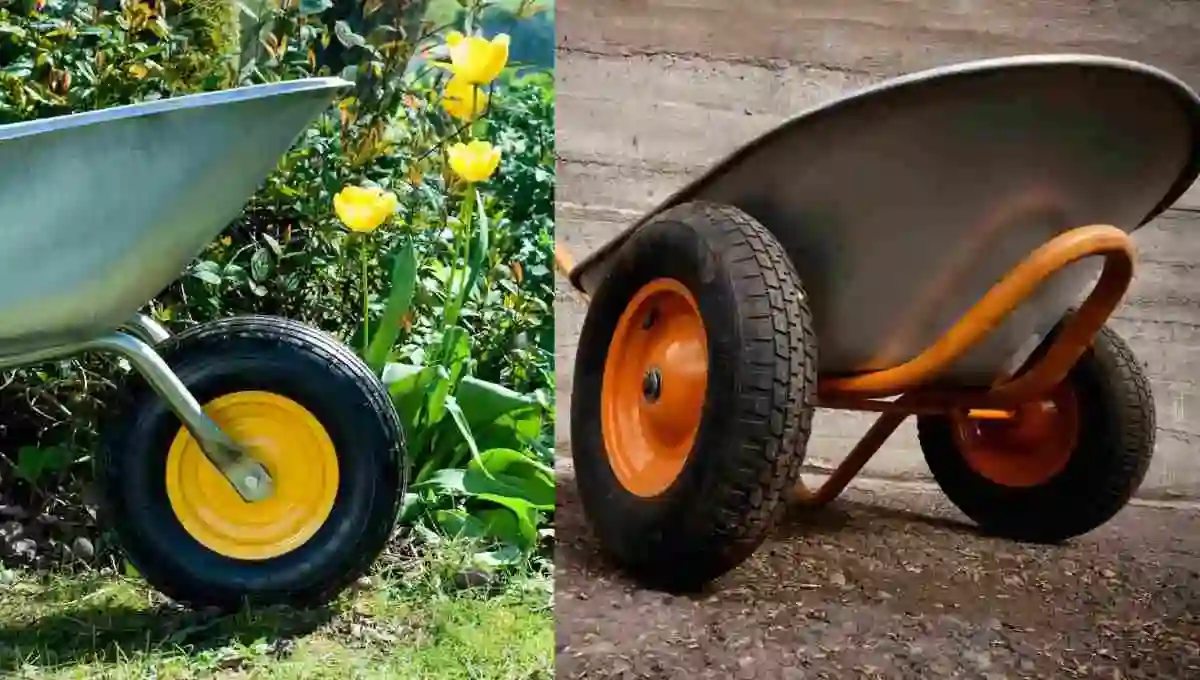A wheelbarrow is a small, hand-operated vehicle with a wheel at the front and two supports at the back for carrying small loads.
It’s a common tool found in gardens, construction sites, and anywhere there is a need to transport heavy materials over short distances.
Whether a wheelbarrow has only one wheel is intriguing and warrants a closer examination.
This article will delve into the traditional wheelbarrow design, variations, and the functionality different designs offer, addressing the question,
Does a wheelbarrow has only one wheel?
Quick Answer: No, not all wheelbarrows have one wheel. While the classic design features a single wheel for maneuverability, modern models often have two wheels for added stability, especially for heavier loads.
Single-Wheeled Wheelbarrows-
Traditionally, a wheelbarrow is designed with a single wheel located at the front.
This design allows for easy maneuverability, as the single wheel can pivot in any direction, enabling the user to navigate tight spaces and uneven terrain with relative ease.
The wheel’s position also allows for the efficient distribution of the load’s weight between the wheel and the operator, reducing the physical effort required to lift and move the wheelbarrow.
Benefits of the Single Wheel:
The single-wheeled design offers several advantages.
Firstly, it provides better control and stability when moving over narrow paths or turning sharp corners.
It also makes the wheelbarrow easier to tilt and dump the load.
Additionally, the design is simpler and typically more lightweight, making it easier to handle, especially for quick tasks or when maneuvering in small gardens or confined spaces.
Two-Wheeled Wheelbarrows-
While the classic wheelbarrow design features a single wheel, there are variations that include two wheels.
Two-wheeled wheelbarrows offer improved stability and balance, making them ideal for carrying heavier loads without tipping over.
This design reduces the amount of effort required to keep the wheelbarrow balanced, which can be particularly beneficial for users with less physical strength or when working on very uneven ground.
Benefits of Dual Wheel:
Two-wheeled wheelbarrows offer improved stability and balance, making them ideal for carrying heavier loads without tipping over.
This design reduces the amount of effort required to keep the wheelbarrow balanced, which can be particularly beneficial for users with less physical strength or when working on very uneven ground.
Multi-Wheeled Wheelbarrows-
In addition to the two-wheeled models, there are also wheelbarrows designed with more than two wheels for specialized applications.
These multi-wheeled options can include configurations that are more akin to a cart, designed for specific tasks or environments where traditional wheelbarrows might not be as effective.
Benefits of Multi-Wheeled:
In addition to the two-wheeled models, there are also wheelbarrows designed with more than two wheels for specialized applications.
These multi-wheeled options can include configurations that are more akin to a cart, designed for specific tasks or environments where traditional wheelbarrows might not be as effective.
They provide even greater stability and load-bearing capacity, making them suitable for heavy-duty tasks in construction, landscaping, and agriculture.
Choosing the Right Design-
The choice of wheelbarrow between a single-wheeled or multi-wheeled wheelbarrow depends on the specific needs and preferences of the user.
Single-wheeled wheelbarrows are preferred for their maneuverability and ease of use in tight spaces, making them suitable for gardening and light construction tasks.
On the other hand, two-wheeled or multi-wheeled designs are better suited for heavier loads and more demanding work environments, offering greater stability and reducing the physical strain on the user.
Practical Considerations-
When selecting a wheelbarrow, it’s essential to consider the type of terrain, the typical load weight, and the user’s physical capabilities.
For uneven or soft ground, a wheelbarrow with larger, pneumatic tires might offer better performance.
The material of the wheelbarrow (e.g., metal, plastic) also plays a role in its durability and suitability for different tasks.
Conclusion-
In conclusion, while the classic image of a wheelbarrow features a single wheel, there are variations that include two or more wheels.
The choice between these designs largely depends on the specific needs of the task at hand, including the load weight, terrain, and user preference.
Whether single-wheeled for maneuverability and ease of use or multi-wheeled for stability and reduced effort, wheelbarrows continue to be an indispensable tool in various settings, evolving to meet the diverse needs of their users.

